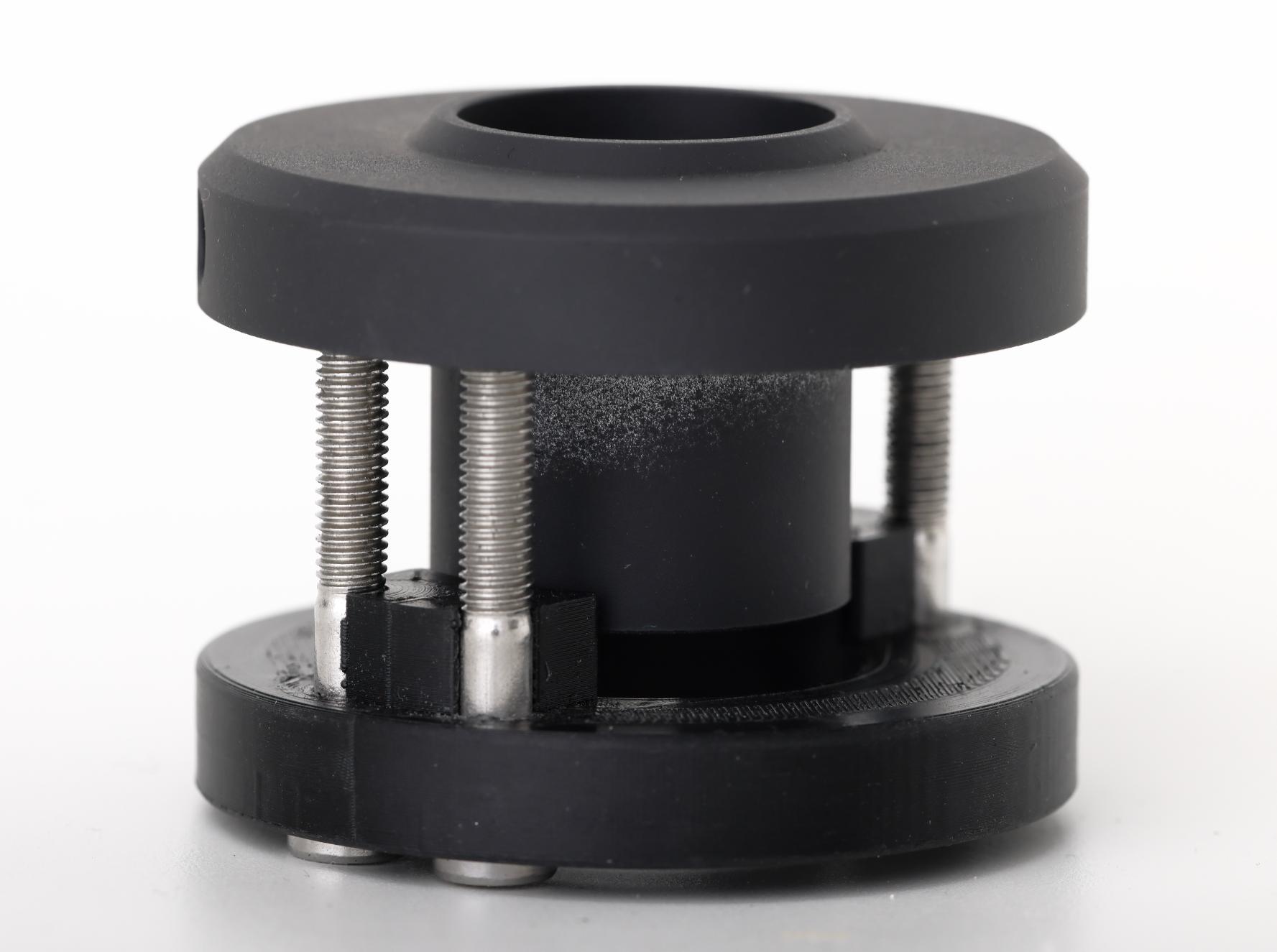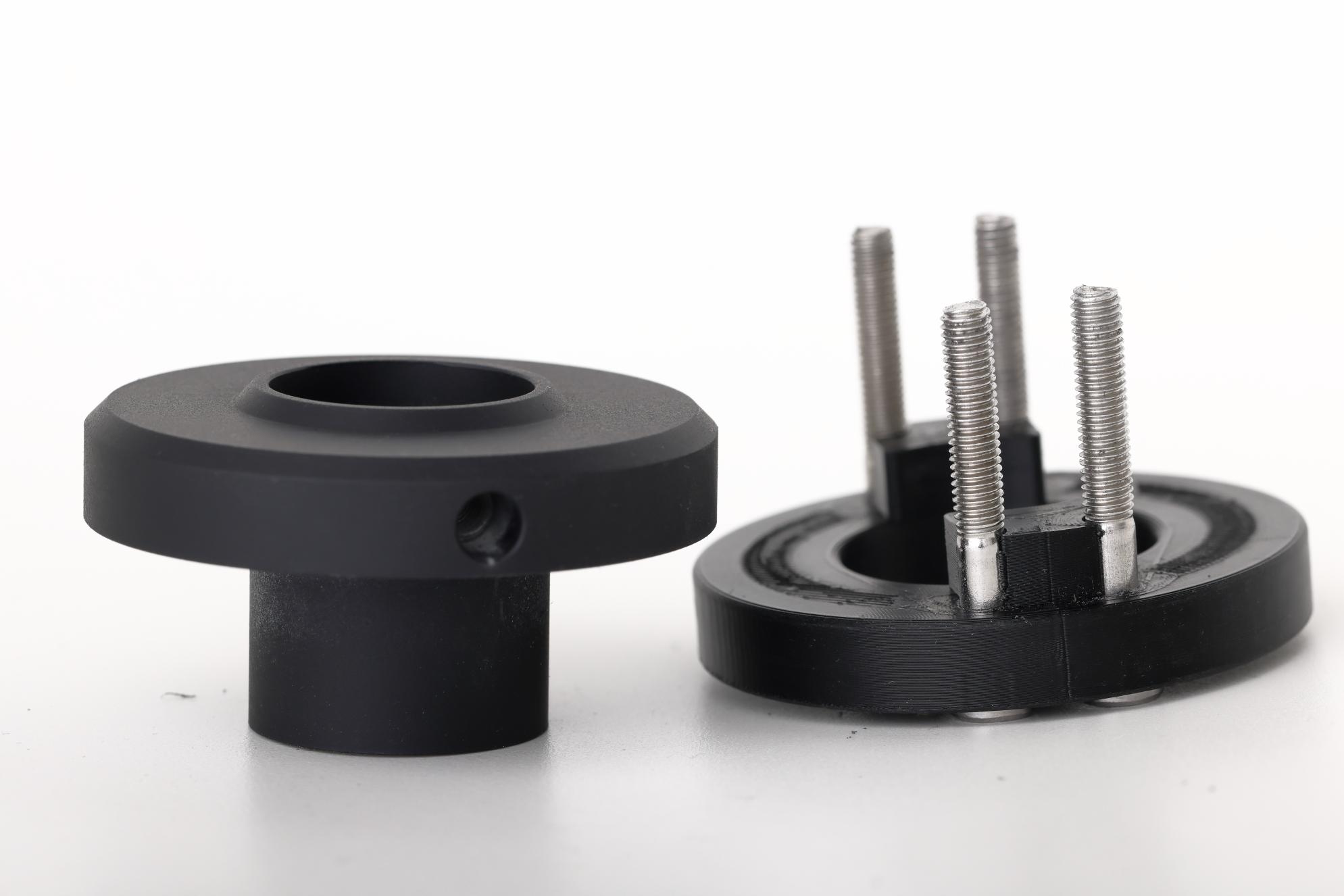You are using an out of date browser. It may not display this or other websites correctly.
You should upgrade or use an alternative browser.
You should upgrade or use an alternative browser.
Sideways Uni-Pivot Arm, SUPATRAC Blackbird, formerly "Ekos Killer (Price?)"
- Thread starter sonddek
- Start date
sonddek
Trade: SUPATRAC
Go on go on go on. Make it a pint!
Alright then. Two halves though. I have responsibilities. Fortunately I have two steady-handed record-changers which double up as beer holders:

sonddek
Trade: SUPATRAC
Received from a customer in Australia today:
The TNT-Audio review will be along any day now.
The speed, musicality and believability are resolutely superior to how the system sounded at home through my LP 12 SE with the same pre and power amps, the presence and pace are brilliant, seriously well done on the arm. I will be replacing the cartridge next week to an MC (either Linn Akiva or ZYX Airy) which if work well I may change to my Linn Kandid from the LP12SE.
Happy for you to share any of my findings, musings if you would like to.
I am sure I have not optimised the arm yet so more to extract from it in due course and I am sure I will be needing your expert advice to gain best results...
Loving it so far.
The TNT-Audio review will be along any day now.
NickofWimbledon
pfm Member
Is there as yet a UK price and a dealer who can demonstrate?
sonddek
Trade: SUPATRAC
SUPATRAC is going to have a room at Bristol 2023 and a stand at Munich 2023. I look forward to meeting you there.
We also have plans to set up a dedicated listening-room-cum-show-room in central London to enable people to hear what the Blackbird can do on a variety of popular decks by appointment. Within reason it should be feasible to bring your deck and either temporarily install a Blackbird or employ a separate arm pod to do comparisons.
I plan to record/film a-b comparisons for youtube/social media too.
We also have plans to set up a dedicated listening-room-cum-show-room in central London to enable people to hear what the Blackbird can do on a variety of popular decks by appointment. Within reason it should be feasible to bring your deck and either temporarily install a Blackbird or employ a separate arm pod to do comparisons.
I plan to record/film a-b comparisons for youtube/social media too.
iansr
pfm Member
Richard
I’m starting to design a plinth for a 301 + my 10.5” Blackbird. I’m on a steep learning curve when it comes to the set up of TTs and I’ve been reading about the 3 common alignment geometries. Is there one of the 3 that you would particularly recommend for the Blackbird?
I’m starting to design a plinth for a 301 + my 10.5” Blackbird. I’m on a steep learning curve when it comes to the set up of TTs and I’ve been reading about the 3 common alignment geometries. Is there one of the 3 that you would particularly recommend for the Blackbird?
sonddek
Trade: SUPATRAC
I am by no means an expert on this topic, and I'm probably less fastidious about eking out every last drop of performance than some, especially since I've been using arms which seem to enable all cartridges to produce astounding results before you've even set them up accurately.
That said, end of side distortion is real, and I do hear it with some ellipticals and worn cartridges, so maybe the decision depends on the type of cartridges you like to use. If you like to enjoy some of the larger ellipticals, Stevenson or Rega does seem to make a bit more sense as you will probably get more consistency. If you stuck to microridge, shibata, FG or good line contacts then Baerwald probably gives a slightly better result across the record if not at the very end. This is orthodoxy; I told you I didn't know much. But I do think end of side degradation is real and a feasible argument for the non-Baerwald geometries.
The Blackbird is Baerwald by default unless you ask for the others. Don't forget there is wiggle room, and many cartridges have outlying bolt-to-stylus measurements, so it's a bit of a movable feast. The Blackbird has a few mm of length adjustability at the pivot, and I cut the headshell holes (and the third/Troika bolt hole) to fit a cartridge with a 7.1mm stylus-to-bolt distance, and then the headshell holes are extended towards the pivot as slots allowing 3.5mm of bolt movement, so that gives compatibility with cartridges which have a stylus-to-bolt distance of up to ~11mm. This means that with many cartridges you can probably reach Stevenson alignment with a Baerwald geometry Blackbird, and you will be very unlucky to find a cartridge incompatibility.
There are of course an infinite number of perfectly viable geometries along the spectrum between Baerwald and Stevenson, and whether they are an optimal compromise could depend on the record, on its important passages, and on how far is its finale from the label.
I love the Audio Technica and JICO microridge styluses for their price, longevity and end-of-side performance. No need for Stevenson with them.
That said, end of side distortion is real, and I do hear it with some ellipticals and worn cartridges, so maybe the decision depends on the type of cartridges you like to use. If you like to enjoy some of the larger ellipticals, Stevenson or Rega does seem to make a bit more sense as you will probably get more consistency. If you stuck to microridge, shibata, FG or good line contacts then Baerwald probably gives a slightly better result across the record if not at the very end. This is orthodoxy; I told you I didn't know much. But I do think end of side degradation is real and a feasible argument for the non-Baerwald geometries.
The Blackbird is Baerwald by default unless you ask for the others. Don't forget there is wiggle room, and many cartridges have outlying bolt-to-stylus measurements, so it's a bit of a movable feast. The Blackbird has a few mm of length adjustability at the pivot, and I cut the headshell holes (and the third/Troika bolt hole) to fit a cartridge with a 7.1mm stylus-to-bolt distance, and then the headshell holes are extended towards the pivot as slots allowing 3.5mm of bolt movement, so that gives compatibility with cartridges which have a stylus-to-bolt distance of up to ~11mm. This means that with many cartridges you can probably reach Stevenson alignment with a Baerwald geometry Blackbird, and you will be very unlucky to find a cartridge incompatibility.
There are of course an infinite number of perfectly viable geometries along the spectrum between Baerwald and Stevenson, and whether they are an optimal compromise could depend on the record, on its important passages, and on how far is its finale from the label.
I love the Audio Technica and JICO microridge styluses for their price, longevity and end-of-side performance. No need for Stevenson with them.
I’ve had one of Richard’s Blackbirds waiting to be fitted for some time now. Today I’ve mounted it on a new LP12 with the addition of a Stack Audio Soprano sub-chassis and Revolution PSU. I had to fit a Cirkus bearing as the PSU is an older one with insufficient clearance for the Karousel. Cartridge is an AT VM740ML. As I don’t have a separate MM phono stage (at least until I build a new PSU) I’ve done some initial listening through an old Rotel 820 integrated. This thing hasn’t been powered up for at least a decade so I wasn’t expecting it to even work let alone sound good.
Well I’m not going to say much at this point as it’s early days but, given what I’ve heard so far, I’m going to say confidently that this arm is staggeringly good. I’m going to have to wait until I can run it through a more suitable system to really form an opinion but I suspect I’m only going find positives to report.
Downsides are not sound but setup related - the bias adjustment is the most fiddly thing since, well, something very fiddly. That said it does offer a vast range of adjustment. And if you want to turn your deck upside-down in a jig then you’re taking the arm off first (@sonddek - am I missing something?).
I’ll come back with more in due course but I have to give congratulations to Richard. I’ll freely admit when I first saw the concept I was skeptical of the design and thought it ugly. I’ve warmed to the looks, it’ll never be pretty like an Ittok or Ekos SE but the design works. Boy does it work.
Well I’m not going to say much at this point as it’s early days but, given what I’ve heard so far, I’m going to say confidently that this arm is staggeringly good. I’m going to have to wait until I can run it through a more suitable system to really form an opinion but I suspect I’m only going find positives to report.
Downsides are not sound but setup related - the bias adjustment is the most fiddly thing since, well, something very fiddly. That said it does offer a vast range of adjustment. And if you want to turn your deck upside-down in a jig then you’re taking the arm off first (@sonddek - am I missing something?).
I’ll come back with more in due course but I have to give congratulations to Richard. I’ll freely admit when I first saw the concept I was skeptical of the design and thought it ugly. I’ve warmed to the looks, it’ll never be pretty like an Ittok or Ekos SE but the design works. Boy does it work.
sonddek
Trade: SUPATRAC
Glad to hear you've got your deck/arm up and running Paul! It does not surprise me that you can hear something special through a Rotel 820 phono input. Good little amps, and I know I've said this before, but my first experience of hearing SUPA prototype 0.0.1 was a Damascene jolt. I genuinely think that many arms out there are a serious bottleneck in expensive and budget systems alike. It's a dramatic demonstration of the source-first doctrine, although if I had two grand to spend I suspect it would be hard to beat a SUPA on an old Technics or Linn.
SUPAs rely on gravity being in the right direction, so yes, you do need to dismount the arm from the pillar to invert a deck without risk. It won't pour silicon oil all over the bench, but it might swing about a bit and put a bit of strain on the bias pulley and electric wires. The hoists can probably stand it, but it was not designed with inversion in mind and I've never inverted one after installation.
I am on the cusp of releasing the special DIN plug I have designed for the arm wires so that you will no longer need to mess around with tweezers to connect the electrics. I may get one in the post to you and others today. I'll post some pictures here shortly too.
This new part is a plug which collects and contains the connector pegs so you just push the plug into the hole in the pillar making all five connections at once. It has a loop and a sideways hole so that you can pluck it out easily too.
It took longer to develop than I had expected because I wanted to ensure that it was compatible with all of the Blackbirds already out there. Existing Blackbird owners will be sent one free of charge.
The new connector plug means that it now takes me fewer than 30 seconds to mount an arm, and dismounting it is quicker.
If you're well-heeled and want to run multiple cartridges on your deck, why choose a detachable headshell arm when you can use a detachable-arm arm, avoiding the questionable rigidity of the light-bulb socket headshell connection? Spare arms will be available at a proportionate price.
SUPAs rely on gravity being in the right direction, so yes, you do need to dismount the arm from the pillar to invert a deck without risk. It won't pour silicon oil all over the bench, but it might swing about a bit and put a bit of strain on the bias pulley and electric wires. The hoists can probably stand it, but it was not designed with inversion in mind and I've never inverted one after installation.
I am on the cusp of releasing the special DIN plug I have designed for the arm wires so that you will no longer need to mess around with tweezers to connect the electrics. I may get one in the post to you and others today. I'll post some pictures here shortly too.
This new part is a plug which collects and contains the connector pegs so you just push the plug into the hole in the pillar making all five connections at once. It has a loop and a sideways hole so that you can pluck it out easily too.
It took longer to develop than I had expected because I wanted to ensure that it was compatible with all of the Blackbirds already out there. Existing Blackbird owners will be sent one free of charge.
The new connector plug means that it now takes me fewer than 30 seconds to mount an arm, and dismounting it is quicker.
If you're well-heeled and want to run multiple cartridges on your deck, why choose a detachable headshell arm when you can use a detachable-arm arm, avoiding the questionable rigidity of the light-bulb socket headshell connection? Spare arms will be available at a proportionate price.
Darren L
Egalitarian
Great that you are offering the new plug FOC to existing owners Richard, appreciated. I can just imagine what a company like Linn would charge for it!
Oh, Linn's new proprietary plug is the Klug held in place by the klasp and their only a million pounds each
wiresandmore
pfm Member
Love reading this thread and congratulations on the arm! I am tempted to try this on my PT Anniversary in the new year. I have an SME armboard for it and it needs to have a DIN connector on the base for the PT flexilink to attach to - is that possible? How is the weight in comparison to an SME IV - would you expect any issues balancing it (the PT is the complete opposite of the Linn with a very light suspension)
sonddek
Trade: SUPATRAC
Love reading this thread and congratulations on the arm! I am tempted to try this on my PT Anniversary in the new year. I have an SME armboard for it and it needs to have a DIN connector on the base for the PT flexilink to attach to - is that possible? How is the weight in comparison to an SME IV - would you expect any issues balancing it (the PT is the complete opposite of the Linn with a very light suspension)
The base and pillar are compatible with both Linn-style arm boards and with SME-type too. The pillar has a DIN socket in the bottom so you should have no problems. Here's a new picture showing the SME-clamp with four bolts, and you can also see the three 120º R24mm bolt-holes for the Linn configuration in the third picture:



The travel for arm length adjustment on an SME arm-board is less than usual due to the bolts, but there is still considerable scope to slide the base backwards and forwards.
As you can see the bolts and bracket clamp the base against the top and underside of the arm-board for good rigidity.
Two sets of four bolts are supplied, longer (shown) and shorter, but depending on your arm-board thickness you may need to cut bolts short or source some M5 bolts of the perfect length.
sonddek
Trade: SUPATRAC
Quick question if I may. Will this fit straight on to a Linn-fit Keel?
Quick answer: yes.
Longer answer: if you use a T-kable or other thickish cable to stabilise your sub-chassis you may need to loosen the P-clip and lengthen your arm cable by a few millimetres because the DIN socket in the bottom of the Blackbird pillar is slightly eccentric in the pillar and its position is therefore a few mm displaced compared to the Linn arms, which have the DIN socket in the middle of the column. Urika users should not be affected since arm cable length is not critical in that configuration. You should probably adjust suspension slightly too since the Blackbird is a little lighter than an Ekos (~500g versus 600g). However, it will work well immediately even if you don't apply these optimisations immediately.


